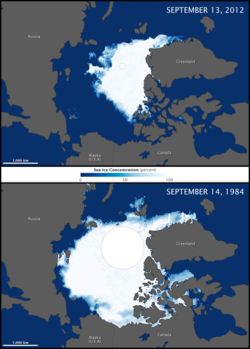Arctic Vegetation Index Trend (EH)
For decades, instruments on various NASA and NOAA satellites have continuously monitored vegetation from space. The Moderate Resolution Imaging Spectroradiometer (MODIS) and Advanced Very High Resolution Radiometer (AVHRR) instruments measure the intensity of visible and near-infrared light reflecting off of plant leaves. Scientists use that information to calculate the Normalized Difference Vegetation Index (NDVI), an indicator of photosynthetic activity or “greenness” of the landscape.
The map shows NDVI trends between July 1982 and December 2011 for the northern portions of North America and Eurasia. Shades of green depict areas where plant productivity and abundance increased; shades of brown show where photosynthetic activity declined. There was no significant trend in areas that are white, and areas that are gray were not included in the study. An international team of university and NASA scientists published their analysis of the NDVI data in Nature Climate Change in March 2013.
The map shows a ring of greening in the treeless tundra ecosystems of the circumpolar Arctic—the northernmost parts of Canada, Russia, and Scandinavia. Tall shrubs and trees started to grow in areas that were previously dominated by tundra grasses. The researchers concluded that plant growth had increased by 7 to 10 percent overall.Relevantní obrázky
Relevantní články
Změna klimatu v ArktiděHlavní environmentální problémy způsobené současnou změnou klimatu v arktickém regionu sahají od dobře známých, jako je úbytek mořského ledu nebo tání grónského ledovce, až po méně známé, ale velmi významné problémy, jako je tání permafrostu, a také související sociální důsledky pro místní obyvatele a geopolitické důsledky těchto změn. Arktida bude změnou klimatu pravděpodobně obzvláště postižena, protože se zde předpokládá vysoká míra oteplování v regionu a s tím spojené dopady. V roce 2007 byly vyhodnoceny prognózy teplot pro arktickou oblast: Ty naznačovaly již průměrné oteplení o 2 °C až 9 °C do roku 2100. Toto rozmezí odráží různé prognózy vypracované různými klimatickými modely, prováděné s různými scénáři ovlivňování. Radiační působení je měřítkem vlivu přírodních a lidských činností na klima. Různé scénáře ovlivňování odrážejí například různé prognózy budoucích lidských emisí skleníkových plynů. .. pokračovat ve čtení













